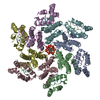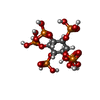+Search query
-Structure paper
| Title | Prion-like low complexity regions enable avid virus-host interactions during HIV-1 infection. |
|---|---|
| Journal, issue, pages | Nat Commun, Vol. 13, Issue 1, Page 5879, Year 2022 |
| Publish date | Oct 6, 2022 |
 Authors Authors | Guochao Wei / Naseer Iqbal / Valentine V Courouble / Ashwanth C Francis / Parmit K Singh / Arpa Hudait / Arun S Annamalai / Stephanie Bester / Szu-Wei Huang / Nikoloz Shkriabai / Lorenzo Briganti / Reed Haney / Vineet N KewalRamani / Gregory A Voth / Alan N Engelman / Gregory B Melikyan / Patrick R Griffin / Francisco Asturias / Mamuka Kvaratskhelia /  |
| PubMed Abstract | Cellular proteins CPSF6, NUP153 and SEC24C play crucial roles in HIV-1 infection. While weak interactions of short phenylalanine-glycine (FG) containing peptides with isolated capsid hexamers have ...Cellular proteins CPSF6, NUP153 and SEC24C play crucial roles in HIV-1 infection. While weak interactions of short phenylalanine-glycine (FG) containing peptides with isolated capsid hexamers have been characterized, how these cellular factors functionally engage with biologically relevant mature HIV-1 capsid lattices is unknown. Here we show that prion-like low complexity regions (LCRs) enable avid CPSF6, NUP153 and SEC24C binding to capsid lattices. Structural studies revealed that multivalent CPSF6 assembly is mediated by LCR-LCR interactions, which are templated by binding of CPSF6 FG peptides to a subset of hydrophobic capsid pockets positioned along adjoining hexamers. In infected cells, avid CPSF6 LCR-mediated binding to HIV-1 cores is essential for functional virus-host interactions. The investigational drug lenacapavir accesses unoccupied hydrophobic pockets in the complex to potently impair HIV-1 inside the nucleus without displacing the tightly bound cellular cofactor from virus cores. These results establish previously undescribed mechanisms of virus-host interactions and antiviral action. |
 External links External links |  Nat Commun / Nat Commun /  PubMed:36202818 / PubMed:36202818 /  PubMed Central PubMed Central |
| Methods | EM (helical sym.) / X-ray diffraction |
| Resolution | 2.81 - 7.85 Å |
| Structure data |  EMDB-27617: Helical reconstruction of A92E HIV capsid in complex with CPSF6 construct (filtered by local resolution)  EMDB-27619: Helical reconstruction of A92E HIV capsid in complex with CPSF6 construct (filtered by local resolution)  EMDB-27625: Helical reconstruction of A92E HIV capsid in presence of FG mutant CPSF6 construct (filtered by local resolution)  PDB-7snq: |
| Chemicals |  ChemComp-IHP:  ChemComp-CL:  ChemComp-HOH: |
| Source |
|
 Keywords Keywords | VIRAL PROTEIN |
 Movie
Movie Controller
Controller Structure viewers
Structure viewers About Yorodumi Papers
About Yorodumi Papers




 human immunodeficiency virus 1
human immunodeficiency virus 1